Ayyappan Thiyyattu
Though Ayyappan Thiyyattu can be clubbed along with Vettekkaran Pattu, Bhagavathy Pattu etc., it is much more than the above all. The main reason is that it has all the elements of similar "pattus", but also has a koothu, resembling the koodiyattam. Items like thottam are dealt very seriously in ayyappan thiyyattu. The other reason is that all the items of the ayyappan thiyyattu except kalam pooja are handled by thiyyadi nambiars, whereas for other similar ritual arts, members of different ambalavasi communities get involved.
The items in an Ayyappan Thiyyattu are:
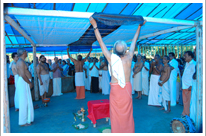
Koorayidal is the ceremonial starting of ayyappan thiyyattu. After uchha pooja, the koora (black coloured sacred lengthy cloth) is handed over to nambiar. With the formal permission of the authorities and priest, while blowing conch, koora is spread above the pandal. Koorayidal is supposed to be the flag hoisting of one-day pattulsavam.
Go to the Top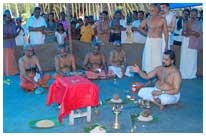
The thiruvayudham (kaduthila or churika) representing the deity is brought from the sreekovil and pooja is offered to Ganapathy and Ayyappa by the priest. Nambiar sings songs evoking Ganapathy, Saraswathy and Ayyappa for their devine presence in the function. Sasthas of 108 traditional ayyappankavus (Ayyappa temples) of Kerala are also evoked by reciting the kavennal thottam. Then the thiruvayudham is taken back to sreekovil and after necessary cleaning, the kalam is drawn under the decorated pandal.
Go to the Top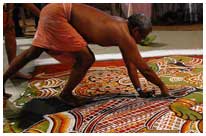
Kalam is multi-coloured floral drawings (dhoolichithram) of various gods and goddesses using traditional designs and colours. This unique tradition pertinent to Kerala is associated with the ritual worship of some of the popular deities. Traditionally, the main three kalams drawn inside the temple are of Ayyappan, Vettekkaran and Bhadrakali done by three different communities.
For Ayyappan Thiyyattu, Thiyyadi Nambiar draws Ayyappan kalam in different forms. The popular kalams drawn are: (1) Ayyappa in standing posture bearing bow and arrow in hands (This is the basic kalam); (2) The same kalam with a prabhamandalam (corona) around; (3) as aswavahana; (4) as pulivahana; (5) as gajavahana (very rarely drawn); (6) moonuroopam (Ayyappan is flanked by consort Prabha on the left and son Sathyakan on the right); (7) swasthika padmakkalam with ashta dala mala - This large size thantric kalam is used exclusively for udayasthamanam koothu (Specified colour pattern of the padma kalam is not supposed to change). The expression on the face of Ayyappa should be satvik. Apart from these, for routine atiyantira thiyyatus, only a lotus is drawn – viz.aninja kalam - in place of roopakkalam.
Kalams (drawings) have a three-dimensional effect. Kalamezhuthu (floral painting) and mural painting are sister art forms. The dhooli chithrakkalam is drawn in the stylised bhoothavativu and the wall painting in the chithravativu style.
Go to the Top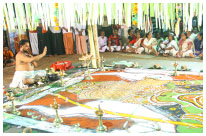
The kalam is decorated with trimmed tender coconut leaves and garments atop, nilavilakkus, raw rice, coconuts, betal leaves, etc. around. The thiruvayudham is again brought and kept along with the valkannadi at the rear end at an auspicious peedom representing the deity and offer special pooja. Once the pooja is over, the kalam is ready for worship just like the deity inside the sanctum sanctorum.
Go to the Top
Thiyyattu is also known as pattutsavam as the element of pattu (music) is very important throughout the art form. The music is sung in a typical style viz. kalampattu style, a branch of Kerala's famous sopana style. It is the thouryathrikasangeetham as the three elements of geetha-nrutha-vadya are done simultaneously or one by one by the same man in thiyyattu unlike the kathakali. There are three types of songs viz.(1) short songs; (2) big ones and (3) thottam. The first two categories are songs praising the hunter god Ayyappa. These two types of songs are sung in different scales of tala viz. moonadi (tripuda), anchadi (panchari), atantha, eka, etc. using the instruments para (small chenda) and ilathalam. Kesadipadam songs of Ayyappa and Vishnumohini are of different type but very important in thiyyattu pattu. The style of rendition is unique and one can only get traces of some of the typical kerala ragas like sankarabharanam, puraneera, padi, sahana, etc. in the kalam pattu. The way and style is very much similar to that of various branches of sopana style viz. kottippadi seva, ottan thullal, nagam pattu, etc. Though the style is comparatively a crude form of sopanasangeetham, it has its own divine charm, creating a divine ambiance with veera-bhakti bhava. (3) The third mode viz.thottam (ritualistic rendition of divine attributes) - is in one way the recitation of story part in a dramatic fashion. The background story of ayyappan thiyyattu - amruthamathanam - is divided into 12 parts. This along with veda pareeksha (debate on veda) between Ayyappa and Indra and few other items like kaavennal (108 main Ayyappa temples) are coming under the category of thottam.
Go to the Top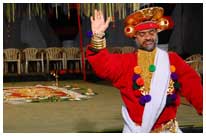
The distinguishing feature of the ayyappan thiyyattu is the rendering of koothu, i.e. pantomimic rendering of the stories of Lord Ayyappa. It is the enactment of the background story of thiyyattu viz. amrithamathanam and the avathara (birth) of Lord Ayyappa out of the divine union of Lord Shiva and Vishnumohini. The last part sankaramohanam ending with avatharam of Sastha is the story mainly played for thiyyattu. The performer of the koothu is assumed to be Nandikeswara, in line with the legend that it was he who explained to Ayyappa in mudras the story behind his birth. Even though the stress is on angika abhinaya with practically no sathvika abhinaya, this ekabhinaya koothu has an innate charm of its own. Bhakthi is the main bhava of koothu. It resembles with koodiyattom in appearance and in the style of enactment of story in mudras. One can also see the forefather of Kathakali in this age old ritualistic art form.
Go to the Top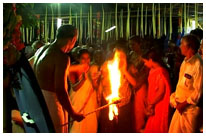
It is a ritualistic pooja part of thiyyattu performed before the final scene of komaram. A torch of an oily cloth, on completion of a simple pooja with kalam pattu at background, is taken to all devotees like arathi. It is believed that all sins and miseries of devotees are perished by paying reverence to this divine torch.
Go to the Top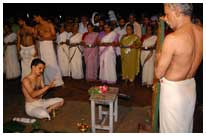
Last and final scene of action 'komaram' (oracle dancer) starts with a pooja viz. mullakkal pattu usually held at the beneath a banian tree outside the temple premises. The oracle in his special attire is offered sacred water, flower garment and finally the thiruvayudham representing the deity after mullakkal pattu. He is taken out in a procession to the temple accompanied by devotees with grand traditional percussion support.
Go to the Top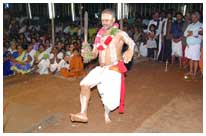
This thantric dance, choreographed to complex steps, done as part of komaram is one of the most attractive dance form of ayyappan thiyyattu. It is also known as "khadga nrutham" as the oracle holds a divine sword (thiruvayudham) in his hand while dancing. It has got two parts, viz. eadu - (tripuda eadu and 4-3-2 beat eadus) in slow-footed steps and various kooru with comparatively speedy steps.
Go to the Top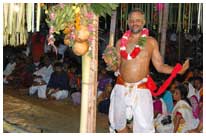
Just like eadum koorum, kalapradakshinam is another form of thantric dance performed by the oracle. With strong percussional back support, the oracle makes various foot steps around the kalam in different scales of thala, viz. chembada, atantha, panchary, champa, eka, etc.for each round displaying weaponry exercises. Its initial movements are comparatively slow but while advancing the encircling of the kalam with manifold steps, this ritualistic frenzied dance form gradually gains momentum and attains the zenith. Both the eadum koorum and kalapradakshinam bear the ethos of kadathanadan kalari, for which the dancer to possess in addition to skill, also, strong brawn to match.
Go to the Top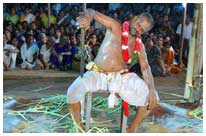
At the climax of the kalapradakshinam, the komaram jumps into the kalam. He, by dancing in a trance mood, cuts down the trimmed tender coconut leaves and wipes out the kalam, except facial part, step by step as per the music and speedy percussional support. Changing the motion swiftly to Sit-n-swinging on a peedom and also advancing in lightening steps, komaram finally erases the face of kalam by hand, making loud shriek in a ecstasy mood puts an end to kalathilattam.
Go to the Top
Pantheerayiram thengayeru (breaking of 12000 coconuts continuously in a rythmic motion) is a unique ceremony performed for both Ayyppan Thiyyattu and Vettekkaran Pattu. It is done when the kalathilattam of komaram attains the halfway. A hill formed of 12000 coconuts is kept at a convenient place where the thiyyattu is held. Paying reverence to the coconut hill, the komaram occupies a seat made of about 300 coconuts in crossed legs posture. At first he breaks few coconuts as offerings to Ganapathy, Ayyappa and guru. Then starts the breaking of the coconuts by alternate hands one after the other with the rhythmic support of melam. To maintain the flow and thala of the ritual unceasingly, helpers pass the coconuts to his hands from both the sides. It may take 3-5 hours for this marathon feat and once it is over, he has to run again to the kalam to complete the final stage of kalathilattam.
Go to the Top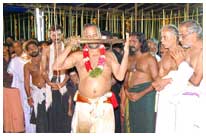
Komaram with thiruvayudham in his hand and possessed by the divine spirit approaches concerned authorities and devotees and utter a few words in a typical style and slang as 'kalpana’. The devotees take the kalpana as the words of the Lord and with faith and devotion, apply the erased kalam powder offered by komaram in their forehead as prasadam.
Go to the Top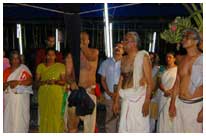
The ritual comes to a formal end when the koora is drawn. This also requires the same formalities of koorayidal.
Go to the Top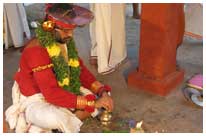
The most elaborate version is the udayasthamanam koothu which shows ayyappan thiyyatu in its most elaborate and loftiest form. The udayashtmanam, as the name indicates, is a day-long rendition of the background story amrutha mathanam-sasthavatharam in the idiom of the koothu. Udayasthamana koothu begins at the dawn and before sun set, all the 12 parts of the story are enacted as koothu one after the other, supported by thottam. The 'cheriyeri', is a ritualistic invocational dance associated with the udayasthamanam koothu, It involves cadence of footsteps with the dancer holding the siva mudra. During this sequence, the ananda-thandava nritha slowly makes Naidikeswara possessed. Cheriyeri resembles the ashtakalasa of kathakali in its eccestatic form and it creates patterns of the loftiest architectural beauty.
It may be worthwhile to mention here that the performer once enters the mandapam for koothu, cannot take food or water till he completes the koothu at evening. Till that time he cannot have his primary needs also. A well trained and experienced hand in Thiyyattu with good stamina can only perform this rare marathon koothu. The udayasthamana koothu can not be conducted alone. A full fledged thiyyattu is performed the previous day of udayasthamana koothu. On completion of the thiyyattu at night, a large thantric padmakkalam, exclusively meant for the udayasthamana koothu is to be drawn before dawn. Then starts the 12-hour long koothu and on completion of the same at sunset, the padmakkalam is erased. As a suffix also, a thiyyattu is held generally followed by Kanalattam /pantheerayiram thengayeru which ends at the next day morning. In that way, this elaborate version of thiyyatu takes more than 40 hours without any break. All departments of the art form are performed in this koothu with three different kalams, all types of songs and thottams, enactment of all parts of the story, two komarams along with pantheerayiram. In connection with the mullakkal pattu of the previous day thiyyattu associated with the oracle, a rare ritual viz. nayattuvili (hunter’s ballad) is to be held, traditionally sung by nair chieftans called vetta kurup.
Go to the Top
The most dangerous role to be done in Ayyappan Thiyyattu is the kanalattam as part of komaram. It is unsafe because a slight negligence on the part of performer may cause to burn his cloth or leg. As in the case of udayasthamanam koothu, an experienced hand can only successfully perform this risky role. Three large heaps of jack wood pieces are nearby kept inside the temple premises. The priest after pooja sets fire all the three wooden heaps sufficiently early so as to get the same as cinder at the time of komaram. While doing eadum koorum, komaram off and on goes hysterically to the fire heaps and with speedy steps he wipes out till the fire is completely put off.
Go to the Top